CS 1205: Music and the Catholic Church: Thursday
Catholic Sprouts: Daily Podcast for Catholic Kids
https://catholicsprouts.com
4.6 • 786 Ratings
🗓️ 16 March 2023
⏱️ 8 minutes
🧾️ Download transcript
Summary
This week is hosted by the Hildegard Collective. Join Cecilia as she journeys through the music history and discover just how interconnected music is with the Catholic Church.
On sale this week, our new book: Write our Names on Your Heart, Family Consecration to the Sacred Heart of Jesus. Get your copy here: https://shop.catholicsprouts.com/products/consecration-to-the-sacred-heart-of-jesus-33-day-preparation-for-families
Connect with the Hildegard Collective here: https://www.thehildegardcollective.com/
Listen to the Hildegard Collective Podcast here: https://www.thehildegardcollective.com/podcast
Connect on Instagram: https://www.instagram.com/thehildegardcollective/
Check out the Catholic Sprouts Podcast ARCHIVES! https://catholicsprouts.com/podcast-archives/
Find fun, meaningful, faith-filled projects for your own family in the Catholic Family Resource Library. https://catholicsprouts.com/catholic-family-resource-library-signup/
Catholic Sprouts is a production of Spoke Street Media.
For more great Catholic podcasts, check out spokestreet.com
Transcript
Click on a timestamp to play from that location
| 0:00.0 | You're listening to Catholic Sprouts, the daily podcast for Catholic kids that strives to plant seeds of faith. |
| 0:28.9 | Hello, sprouts. Today is Thursday, March 16th, and I'm Cecilia Leskowitz from the Hildegard Collective, a ministry for Catholic musicians. We're time traveling this week through musical |
| 0:34.4 | history in the Catholic Church, and today we'll be picking up where we left |
| 0:38.3 | off in the early 1800s, and we'll travel to the beginning of the 1900s. But before we begin, |
| 0:45.4 | let's review what we learned about yesterday. We traveled through the Baroque and the classical |
| 0:50.7 | time periods. We learned about how Catholic composers in this time were writing music |
| 0:55.9 | for both sacred settings and settings outside church, and we met the composers Antonio Vivaldi |
| 1:02.2 | and Wolfgang Amadeus Mozart. Today, we're going to learn about the romantic time period. |
| 1:08.8 | Now, you might hear the word romantic and think about falling in |
| 1:12.4 | love, like in fairy tales or Disney movies. But in the 1800s, the word romantic meant more than that. |
| 1:20.6 | There was a whole movement in books and art called the Romantic Movement, and it focused on |
| 1:26.3 | things like nature and the meaning of life. |
| 1:29.8 | Remember how we learned the other day that new things in music come after new things in art? |
| 1:34.9 | This happened here in the Romantic time period, too. |
| 1:39.0 | Music historians say that the Romantic era began around the year 1827, which was a little later than the romantic |
| 1:47.1 | movement started in art and books. Composer still used key signatures and counterpoint |
| 1:53.3 | during this time, but they started to push the rules and explore something called chromatic notes. |
| 1:59.6 | These were notes that didn't fit inside a key signature, |
| 2:02.9 | but they make melodies glide around and become either flashier or more thoughtful, depending on |
| 2:09.1 | how the composer wants to use them. During the romantic period, composers were still writing |
| 2:15.6 | sacred music, but it was more because it was a thing to do for the |
| 2:19.6 | composers, rather than because they loved God. See, the world was changing really quickly during this time. |
... |
Please login to see the full transcript.
Disclaimer: The podcast and artwork embedded on this page are from https://catholicsprouts.com, and are the property of its owner and not affiliated with or endorsed by Tapesearch.
Generated transcripts are the property of https://catholicsprouts.com and are distributed freely under the Fair Use doctrine. Transcripts generated by Tapesearch are not guaranteed to be accurate.
Copyright © Tapesearch 2025.

